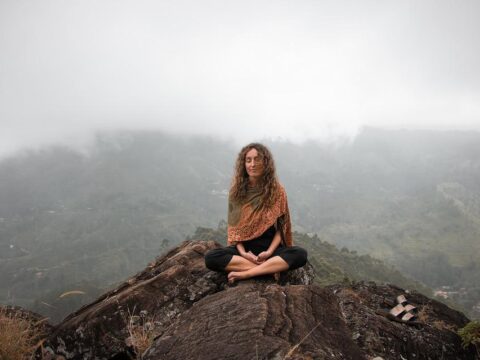The concept of ahimsa is a Sanskrit word meaning “non-violence” or “do no harm”. Although the exact definition is disputed, it generally refers to non-violence towards others and oneself.
One of the reasons why it is so important to practise ahimsa is that it is the first step on the 8-fold path to enlightenment. By being mindful of all living beings, we can begin to develop compassion for ourselves and others. This can help us to become better leaders and better human beings.
In this way, we are able to live our lives peacefully, leading to greater happiness and fulfilment for all.
Podcast
The importance of Ahimsa
Many people tend to look down on Ahimsa. They think it is too difficult or simply unnecessary. The fact is, however, that practising ahimsa is just as important as practising any other spiritual principle. Often it is even more important because it affects our daily lives in a much more profound way than most spiritual principles.
When we practise Ahimsa, we are less likely to intentionally hurt others. We will be less likely to commit suicide, steal or murder.
We will be able to develop better relationships with our family, friends and co-workers. Our interactions with others will improve.
In addition, we will also be able to gain more insight into ourselves. This will allow us to grow as human beings and learn more about what makes us happy and unhappy.
How can I practise Ahimsa?
Practising Ahimsa is very simple. All it takes is a willingness to be mindful of others and to get out of your own way.
You don’t have to worry about being perfect in this sense. It is enough to know that it is possible to practise ahimsa and to recognise the harm that comes when you hurt others.
If you are not sure what this means, you can simply ask yourself if you want someone to do something to you. If you answer yes, then you are already practising Ahimsa.
If you are really looking for ways to practice ahimsa, here are some ideas you can try:
- Refrain from swearing or calling someone names in a violent way.
- Try to be more mindful of your actions and make sure they do not cause harm.
- Do not gossip about other people.
- Do not share negative or embarrassing information about other people.
- Do not criticise or badmouth other people.
- Do not lie or cheat.
- Do not steal.
- Do not take advantage of others.
- Do not spread hatred.
- Do not harm animals.
Why does yoga teach ahimsa?
Yoga teaches you to respect yourself, which means you are not here to hurt anyone else. You are here to love yourself and to love those around you.
Yoga teaches you to let go of fear, which means you have nothing to fear. You are not here to harm anyone, so why should you fear something that does not exist?
Yoga teaches you to trust yourself, which means you are not here to hurt anyone else. You are here to learn and grow, and you are here to make the most of life.
Ahimsa in the Yoga Sutras
The yamas are the restraints or moral precepts that promote self-discipline and purification of the mind. The Yoga Sutras, an ancient yogic text compiled by the Indian sage Patanjali, contains the eight-limbed path.
The first limb of this path is the yamas. The yamas are restraints or moral precepts that promote self-discipline and purification of the mind.
The yamas are the foundation for the inner practice of yoga and the first step on the spiritual path of yoga. Although they were written down at least 1700 years ago, they can still be applied to modern life, albeit in a different way than before.
The first yama is ahimsa, which means non-violence or non-harming. So yogis practise ahimsa by being kind to all living beings and the planet, and by choosing peace and love over war and violence.
The other four yamas are:
- Satya (truthfulness)
- Asteya (non-stealing)
- Brahmacharya (celibacy or right use of energy)
- Aparigraha (non-possession or non-greed)
How to practise Ahimsa in daily life
There is a lot of violence in the world right now, and you can see it if you follow the news. Many of us don’t have Ahimsa in our lives, which is a shame. Even though you cannot end all suffering, you can still take a vow to practise Ahimsa, which might inspire other people to do the same.
You can apply the first yama in your life by practising yoga, eating healthy food and meditating.
Reduce violent actions, words and thoughts towards others. It is not realistic to expect that you will never again respond to a stressful situation with violence or hurtful words. Don’t set yourself the goal of perfection, but become aware of the harmful things you are currently doing.
The yamas enable us to become more aware of ourselves so that we can become the best version of ourselves. It takes time to progress in personal or spiritual development, but the more we become aware of our shortcomings, the easier it becomes to change our behaviour.
Every time you think or say something negative or react to a situation with violence, try to catch yourself doing it. At first you may not realise you have done it until later, but with practice you will notice it within a few minutes.
Over time you will become more aware of yourself and be able to catch yourself before you become violent. Then you have control back and can change your actions, words and thoughts.
Lead a more sustainable life
Practising ahimsa means showing respect and compassion not only to other people, but to all living beings and to nature. Therefore, it is important to pay attention to how our choices and actions affect the environment in order to protect and care for the world.
You can help the environment in many ways, for example by recycling, reducing plastic consumption, not buying from ‘fast fashion’ companies or walking instead of driving. All of these things help to reduce global pollution, keeping wildlife healthy and the planet in balance.
Eat a vegetarian or vegan diet
One of the most prominent discussions around ahimsa today is meat consumption and the detrimental effects it can have on negative karma.
Does one need to switch to vegetarian or vegan? That is for each person to decide for themselves. But depending on the circumstances, one can reduce meat consumption.
How to practise non-violence in yoga practice
It can be easy to push ourselves too hard physically or strive for perfection in our postures instead of listening to our bodies and meeting ourselves where we are.
If you don’t treat yourself lovingly in your daily life, you probably won’t in your asana practice either. There are many ways we can unintentionally hurt ourselves on the mat. It can be easy to push ourselves too hard physically or strive for perfection in our postures instead of listening to our bodies and meeting ourselves where we are.
Respect the limits of your body
Whether you are just starting yoga or have been doing it for a while, you might try to ask your body to do more than it is actually capable of during your practice. As a beginner, it’s normal to want to progress quickly so you can keep up with the class and do all the poses. However, if you attempt poses that your body is not ready for, you could injure yourself.
If you are practising yoga and feel that you are not improving or cannot do certain poses, you may become frustrated. This can lead to harmful thoughts about yourself as you might think you are not good enough. Or you may tell yourself that you are not trying hard enough and put even more pressure on your body, which can lead to physical self-harm.
Even though yoga can help improve our flexibility, we should remember that everyone has a different bone structure, which means that some poses are harder for us than others. It is important not to get discouraged and understand that this is normal.
Pay attention to how you feel every day
It is important to listen to our bodies and not push ourselves beyond our limits. It is important to respect your body’s limits and listen to how you feel each day.
Some days you may feel full of energy and able to perform more advanced yoga postures or a more difficult yoga flow. Other days you may feel tired and need something gentler and more restful. It is important not to push yourself beyond your limits.
If we try to push ourselves too hard in every yoga class, we ignore our body’s needs. Therefore, it is important to recognise and accept that we feel different every day and accordingly approach each session differently. If we can do this, we can use the yoga practice as it is meant to be used, namely as a tool to nourish our body, mind and spirit.
When you do a body scan, you move your awareness from your head to your feet and notice how each part of your body feels. This will help you determine if you are experiencing any pain or tension and if there are certain parts of your body that you need to be gentle with during your practice.
When you have finished the body scan, take a few minutes to breathe into your heart centre and let any emotions that are present come up.
If you feel emotions coming up, don’t try to explore the feelings or push them away, just stay with them. This will help you understand how you are feeling emotionally that day and what kind of exercise you need.
Don’t compare yourself to others
As humans, we often compare ourselves to others. Whether we are comparing our lives, our yoga practice or the number of followers we have on social media, we want to see what other people are doing. The problem with this is that if someone seems to be doing something better than us, we feel bad and think we’re not as good as them.
Don’t worry about what others are doing in yoga class, focus on your own practice.
Final thought
The first step on the yoga path is to follow the guidelines of Ahimsa. This will help us to become kinder, more compassionate and loving people and help us on our spiritual path to enlightenment.




